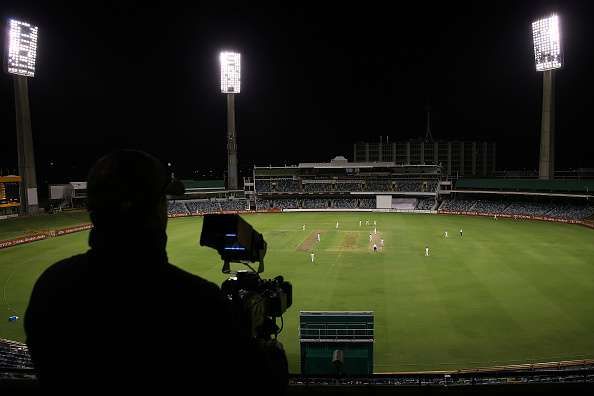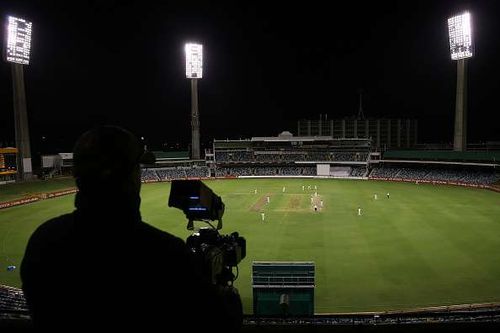
The unsung hero of a cricket broadcast
Television broadcasts of today are impeccable. With the sole objective of transporting a viewer from the couch to the pitch, the producer relies on an array of cameras to capture the action.
Tune into a cricket broadcast and you see the familiar sight of the bowler running in, the batsman driving and scampering between the pitch. The next ball, the cycle repeats itself, as it does through the course of the game.
But the viewer is never bored. Its a sight that typifies the game itself. But where and how do these images originate from? That's a question that we seldom ask. But little do the viewers realise that these "straight-on" visuals of ball-to-ball action through the course of a cricket match are in-fact the handy work of cameramen.
In this day and age of robotics, the cameraman is for real, i.e. living breathing human being. Take the cameraman out of the equation and your favourite slow-motion visual of the Sachin Tendulkar bowler's-back-drive would remain an on-field statistic.
Stationed high and deep in the stands, far away from all the action in the middle, the cameraman quietly goes about his business. He has but a singular job at hand - hold the video-camera steady and watch the ball. Yes, just like a batsman.
"We are camped here all day long", says Hemanth Pal, a cameraman covering the Karbonn KPL action at Hubli, Karnataka.He is stationed, all by himself, on a makeshift wodden stand that is almost 50 feet above the ground. It’s a solitary confinement of Rampunzel proportions. Perched atop this stand and above the sight-screen, he is line with the pitch.
When a batsman lets one go through the keeper, Hemanth's job is easy. But when Robin Uthappa plays an imaginative reverse-sweep, he needs to quickly adjust, swerve to his right and keep the ball in his frame as it bounces over the ropes.
A fabulous occupation, you'd think. You get to stroll along the ground, video-tape famous personalities and more importantly, get paid to watch cricket. But its not all easy and glamorous as one might imagine.
"We need to stand all day long and track the ball", Hemanth says. "We cannot afford to miss the ball as the viewers do not get to see it on TV and the viewing experience goes bad".
And the pressures of ball-tracking aren't the only demons that cameramen are battling. If it were to rain, the wodden platforms that house of the camera station gets precariously slippery. With no railing on either side, one wrong step will send Hemanth hurtling down to certain catastrophe.
And that isn't the only concern that crosses his mind. Standing for long hours take a toll on the body as well. "The back hurts after a while", Hemanth says. He explains that his colleagues on the ground aren't spared either.
"For the pitch report and interviews in the dug-out, we need to carry the camera over our shoulders and move around. It (the camera) is heavy and our shoulders hurt badly".
So an occasional downpour between the game, a sight of frustration for the players and viewers, is instead a welcome sight for Hemanth. "When it rains and there is no play, we get a break. So that's good", he says with a smile.
Intrigued by these confessions, I probed on. Just how does one become a cameraman? "Film schools offer courses that can be done", he says. "Otherwise, one can become an assistant and then learn", he adds while recalling his own foray into the profession.
"I started as an assistant, then became a camera man for on-ground coverage and now I am a camera man in the stands behind the bowler". Most cameramen are freelancers, hired by production companies for an event that might span a few days. Needless to say, it's a nomadic life.
"I move from one event to another. Reality shows, football matches and cricket tournaments". Just when you're awe of all the worldly exposure and variety the profession offer, the mood turns somber. "I have a busy life and haven't gone home in 3 years", Hemanth says.
It is then that you pause for a moment and reflect. There are always two sides to a story and the grass is more often than not, greener on the other side.
The rain has now subsided and as the players make their way out to the field, Hemanth must get back to his gear. He dons his heads-phones and places his hands over the equipment to focus on the pitch.
Soon enough, the mercurial Manish Pandey is out in the middle and sends the ball soaring in the stands. Hemanth is alert as ever and tracks it all the way while breaking into a brief smile as a measure of self-appreciation for having pulled off the feat. He then pans his camera back to the pitch and is ready for the next ball.
The cameraman is a vital cog in the wheel that we call a live-broadcast. With unforgiving audiences unwilling to settle for nothing less than the sight of the ball crashing into the boundary hoardings, the demands of the profession are immense. Yet, the cameraman is a forgotten entity.
So the next time, you're watching a cricket broadcast and see Virat Kohli sending a pull-shot to the fence, appreciate not just the skill of the stoke, but also the handy work of camermen like Hemanth. For, it’s because they keep their eyes on the ball that we are able to appreciate cricket in the manner that we do from the comfort of our living rooms.
Play of the day: Ravichandran Ashwin trumps Kane Williamson with a special delivery
